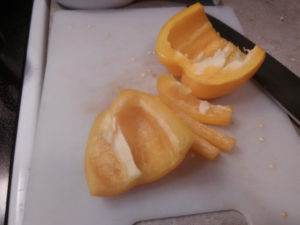 A bit of a preamble. I often say things which are completely true, only to be confronted by people who flat out claim that I’m only making it up. That I *must* be making it up. There’s no way the very true thing I just said is true.
A bit of a preamble. I often say things which are completely true, only to be confronted by people who flat out claim that I’m only making it up. That I *must* be making it up. There’s no way the very true thing I just said is true.
I’ve learned to cite my sources. So, before we begin, a word about the color purple. Not the movie, although it was good. Very good. Alice Walker’s novel won the Pulitzer in 1983, and went on to become both a hit musical, and the film starring Whoopi Goldberg in her debut as an actress. It might have been something far less in the hands of a director other than Steven Spielberg. But no, not here to discuss film. Here to discuss food, so:
Anthocyanins! Water-soluble, vacuolar, pH-sensitive pigments! Part of a parent class of molecules known as ‘flavonoids’. Mostly 3-glucosides of the anthocyanidins… The important bit is that under the right conditions, they make plants PURPLE.
All plants have some anthocyanins in them; in the stems, the leaves, the fruit, or the flowers. So, finding a natural variety of say, wheat, with a particularly high anthocyanin content in the grain is, in fact, entirely expected. This is what we find: Ethiopian Blue-Tinged Emmer. It is a cultivar selected in (obviously) Ethiopia by Dan Jason of Salt Spring Seeds, who brought back two blue-tinged seeds from a trip to Ethiopia in 1993.
“Purple grain colour is caused by anthocyanins in the pericarp whereas blue colour is caused by anthocyanins in the aleurone layer. Purple grains occur in tetraploid wheats from Ethiopia, and in one bread wheat accession apparently native to China.” –Zeven, A.C. Euphytica (1991) 56: 243. https://doi.org/10.1007/BF00042371
Tetraploid wheat. Not diploid like commercial wheat. Wouldn’t it be fun to cross a tetraploid wheat with rye? You’d get tetraploid triticale. And if you used an anthocyanin wheat, you’d have Anthocyanin Quadrotriticale! Super-hardy, purple, grows-almost-anywhere wheat, and the Klingon Empire would kill to get this stuff. And Guinan would advise Picard to keep it away from the Ferengi. Hey, there’s Whoopi Goldberg again!
But, I’m supposed to be cooking, aren’t I? I’m getting to it, really I am.
Hagos Hailu Kassegn has done a full determination and analysis of the proximate bioactive compounds in anthocyanin wheat. Total anthocyanin content (TAC) in anthocyanin-colored purple wheat was found to have a mean value of 197.4 mg/100 g. — Hagos Hailu Kassegn & Fatih Yildiz (2018) Determination of proximate composition and bioactive compounds of the Abyssinian purple wheat, Cogent Food & Agriculture, 4:1, DOI: 10.1080/23311932.2017.1421415
Purple wheat is a very real thing. Its Abyssinian origins have been known for over 100 years.
It only stands to reason, therefore, that there must be purple wheat products. I don’t have to invent imaginary purple wheat noodles. There are real purple wheat noodles out there. Let’s go find some.”¨”¨Hans Lienesch, runs a blog called “The Ramen Rater” from his home in Edmonds, WA. Not too long ago, he rated Purple Wheat Noodles from Koka in Singapore.
https://www.theramenrater.com/2014/01/11/1282-koka-purple-wheat-noodles-aglio-olio-flavor/
Ta-da! There they are. A purple wheat product. Made slightly MORE purple by the addition of some blue corn.

What are we going to do with these purple wheat noodles? We’re not making ramen, that’s certain. Anthocyanins are water soluble, didn’t I say so? They’ll turn the broth purple. Totally not fun. Indeed the package of Agilo-olio flavor Purple Wheat noodles is labeled “Dry Noodles.” Not technically ramen, but intended for stir-fry dishes.
So”¦
Where to find purple wheat noodles? It just so happens that I spent the first six months of 2018 across from the coolest multi-ethnic supermarket in the known universe: Saars. It’s kinda like H-Mart only more or less regional to the Seattle area (sorry, entire rest of the planet). Imagine that the very best Asian market and the finest Mexican market fell madly in love with each other (apparently this story is best told by Chuck Tingle), and eloped to Las Vegas for an impromptu wedding complete with Elvis impersonator. Saars is their love-child.”¨So here we are in my kitchen with a FIVE-PACK of Koka Purple Wheat Noodles, some onion, bell peppers, and thin slices of beef.
This next bit is really simple. Prepare the noodles to package directions and set aside. Sauté the beef and set aside. Slice the onions, and peppers and sauté. Reintroduce the beef to the pan, add in the noodles, and plate in shallow bowls. Yes, I know. This is nearly 800 words just for a single paragraph of not really recipe.

Top with mixed crushed nuts, fried onions, and sesame-seed furikake. This is a delightful meal and multi-colored to boot. Whether or not anthocyanin actually have any real dietary impact is an exercise best left to a nutritionist.
Enjoy this writing advice and want more content like it? Check out the classes Cat gives via the Rambo Academy for Wayward Writers, which offers both on-demand and live online writing classes for fantasy and science fiction writers from Cat and other authors, including Ann Leckie, Seanan McGuire, Fran Wilde and other talents! All classes include three free slots.
If you’re an author or other fantasy and science fiction creative, and want to do a guest blog post, please check out the guest blog post guidelines.









